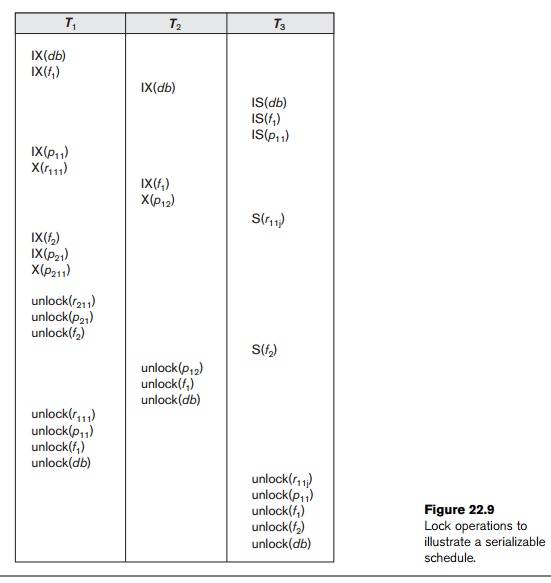Chapter: Fundamentals of Database Systems : Transaction Processing, Concurrency Control, and Recovery : Concurrency Control Techniques
Using Locks for Concurrency Control in Indexes
Using Locks for Concurrency Control in Indexes
Two-phase locking can also be applied to indexes, where
the nodes of an index correspond to disk pages. However, holding locks on index
pages until the shrinking phase of 2PL could cause an undue amount of
transaction blocking because searching an index always starts at the root. Therefore, if a transaction wants to insert a
record (write operation), the root would be locked in exclusive mode, so all
other conflicting lock requests for the index must wait until the transaction
enters its shrinking phase. This blocks all other transactions from accessing
the index, so in practice other approaches to locking an index must be used.

The tree structure of the index can be taken advantage of when
developing a con-currency control scheme. For example, when an index search
(read operation) is being executed, a path in the tree is traversed from the
root to a leaf. Once a lower-level node in the path has been accessed, the
higher-level nodes in that path will not be used again. So once a read lock on
a child node is obtained, the lock on the par-ent can be released. When an
insertion is being applied to a leaf node (that is, when a key and a pointer
are inserted), then a specific leaf node must be locked in exclusive mode.
However, if that node is not full, the insertion will not cause changes to
higher-level index nodes, which implies that they need not be locked
exclusively.
A conservative approach for insertions would be to lock the root node in
exclusive mode and then to access the appropriate child node of the root. If
the child node is not full, then the lock on the root node can be released.
This approach can be applied all the way down the tree to the leaf, which is
typically three or four levels from the root. Although exclusive locks are
held, they are soon released. An alternative, more optimistic approach would be to request and hold shared locks on the nodes leading to the
leaf node, with an exclusive lock on
the leaf. If the insertion causes the leaf to split, insertion will propagate
to one or more higher-level nodes. Then, the locks on the higher-level nodes
can be upgraded to exclusive mode.
Another approach to index locking is to use a variant of the B+-tree, called the B-link tree. In a B-link tree, sibling
nodes on the same level are linked at every level. This allows shared locks to be used when requesting a page and
requires that the lock be released before accessing the child node. For an
insert operation, the shared lock on a node would be upgraded to exclusive
mode. If a split occurs, the parent node must be relocked in exclusive mode.
One complication is for search operations executed concurrently with the
update. Suppose that a concurrent update operation follows the same path as the
search, and inserts a new entry into the leaf node. Additionally, suppose that
the insert causes that leaf node to split. When the insert is done, the search
process resumes, following the pointer to the desired leaf, only to find that
the key it is looking for is not present because the split has moved that key
into a new leaf node, which would be the right
sibling of the original leaf node. However, the search process can still
succeed if it follows the pointer (link) in the original leaf node to its right
sibling, where the desired key has been moved.
Handling the deletion case, where two or more nodes from the index tree
merge, is also part of the B-link tree concurrency protocol. In this case,
locks on the nodes to be merged are held as well as a lock on the parent of the
two nodes to be merged.
Related Topics